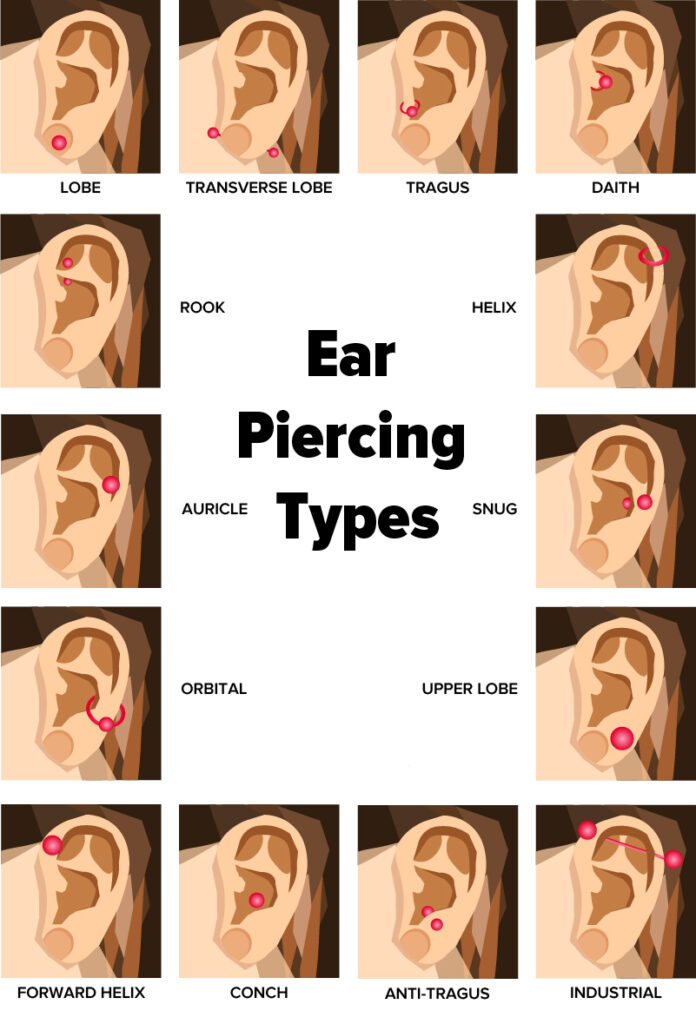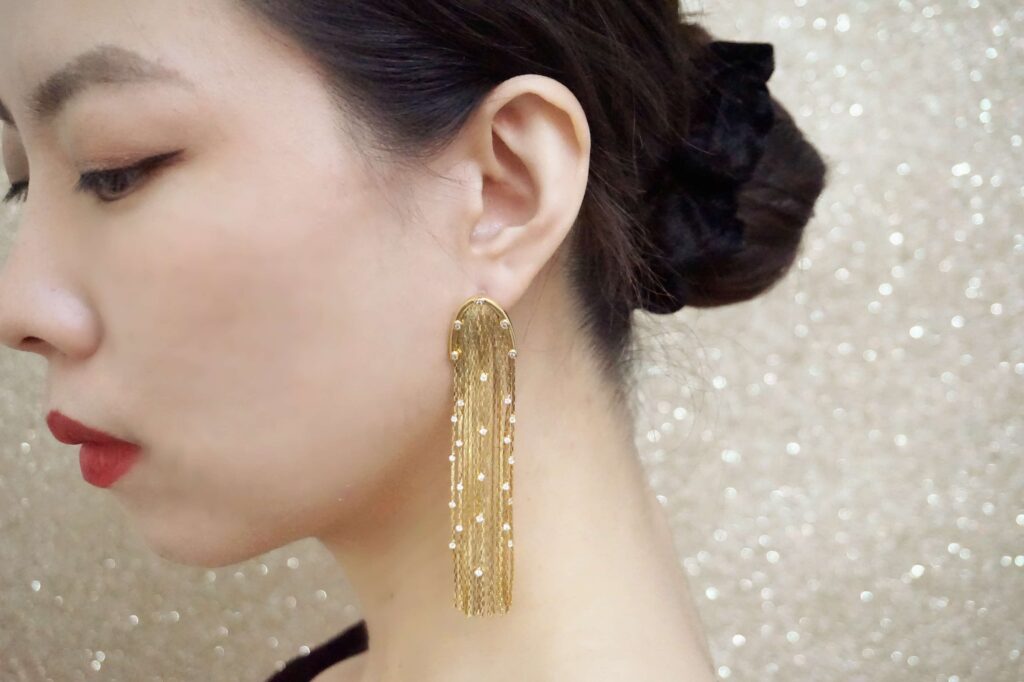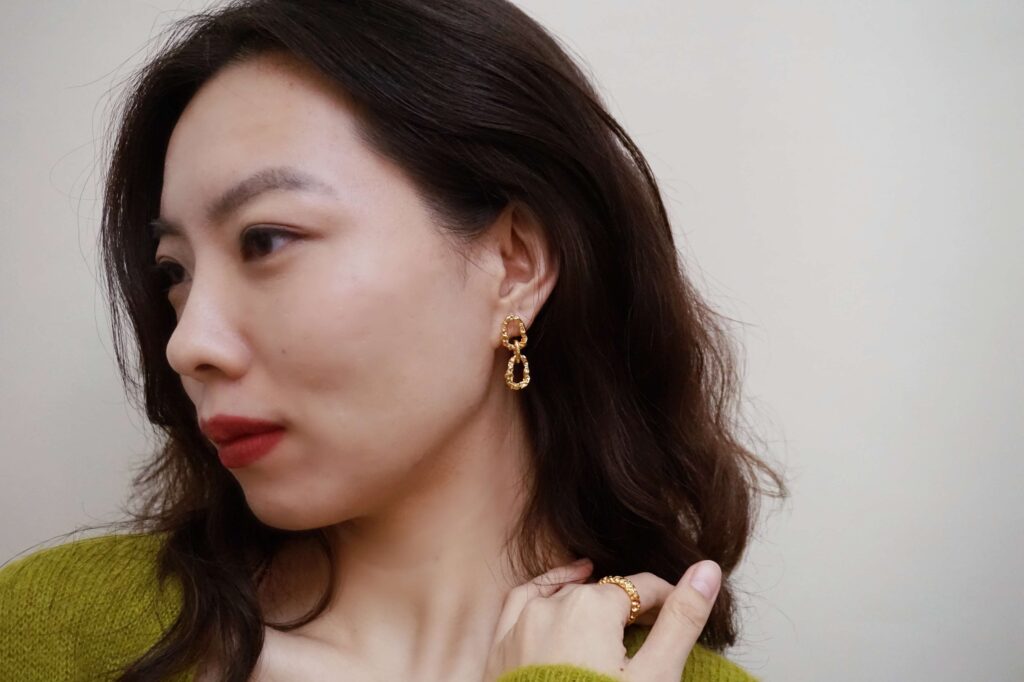Least and Most Painful Piercings
Every piercing is painful since skin is being punctured, but there are some piercings that are more painful than others. Before getting any piercing, it’s important to know what you’re in for.
Types of ear piercings you can get
While ear piercings come in a variety of forms, they can be broadly grouped into three main types, namely:
Outer Ear Piercings: Snug piercing, tragus piercing, industrial piercing, forward helix piercing, auricle piercing.
Earlobe Piercings: Transverse lobe piercing, standard lobe piercing.
Inner Ear Piercings: Helix piercing, anti-tragus piercing, daith piercing, rook piercing, orbital piercing, outer conch piercing.
Now, let’s put the different piercings on the pain scale and see how high each one ranks.

Least painful ear piercings
Standard lobe ear piercing
Pain Level: 3/10
This is the first piercing that everyone gets. Because it is the least painful of all ear piercings.
Most people who have this type of piercing describe the pain as a brief squeeze that occurs as the needle goes through. People are more likely to complain about painful pressure after a piercing. Standard earlobe piercings fully heal in 1-2 months and are very acceptable for first-time piercings.
Transverse lobe ear piercing
Pain Level: 4/10
A transverse lobe piercing is a horizontal piercing through the earlobe. It’s a little more complicated than a standard earlobe, and slightly more painful. The pain increases because the piercer has to pass through more skin before it can finish. However, it is much less painful than a cartilage piercing. Most people with a transverse lobe perforation will fully heal within 2 months, but some may take up to 10 months.

Mildly painful ear piercings
Helix ear piercing
Pain Level: 4.5/10
Helix piercings are probably the least painful of all cartilage perforations. It is placed on the outer upper edge of your ear, where the cartilage is thinnest.
While helix piercings are not as painful as other cartilage piercings, the pain can increase if there is more than one piercing. The pain you feel also depends on the shape of your ear. Spiral piercings take 3-6 months to heal.
Tragus ear piercing
Pain Level: 4.5/10
Tragus piercings are one of the most stylish piercings and look great with other jewelry. The tragus is the cartilage that sits above the ear canal. It is about the same pain level as a helix piercing.
The tricky part of tragus placement is keeping the tragus clean during the healing process. You should avoid irritating the area to avoid infection. Avoid devices such as cell phones and earplugs for the first few weeks after your piercing.
Tragus piercings take longer to heal than helix piercings, but they usually heal completely between 6-12 months.
Orbital ear piercing
Pain Level: 5/10
Orbital piercings are similar to industrial implants (one of the most painful piercings), but with the pain level of a helix piercing. It also has a shorter healing window than two piercings.
A track piercing consists of two holes connected by a hoop. You can choose to place it under the helix or on the earlobe. It usually heals between 2-3 months.
Forward helix ear piercing
Pain Level: 6/10
The forward helix piercing is placed opposite your hairline and above your tragus. It has a slightly higher pain level than the orbital piercing and takes about 3-9 months to heal.
The beautiful thing about the forward helix piercing is, like the helix placements, you can get multiple piercings of this kind on both ears. Forward helix piercings also require minor care once they heal.
Moderately painful ear piercings

Daith ear piercing
Pain Level: 6.5/10
Daith piercing is a hoop that goes around the fold of cartilage inside the ear. Some people believe this piercing helps with chronic migraines because it’s located on the acupuncture point. But no scientific research supports this claim.
Daith piercing is more painful than a forward helix puncture because the cartilage is thicker. It takes approximately 6-9 months for a daith piercing to fully heal.
Conch ear piercing
Pain Level: 6.5/10
The location is on the cartilage next to the curvature of the ear. There are two forms of this placement type; the inner conch piercing is placed on the inner cartilage of the ear and consists of a stud, and the outer conch piercing is placed between the helix and the helix. Conch placement offers more variety than other piercings, which is why it is popular.
The pain felt during the piercing is due to the thickness of the cartilage involved. Both forms are about the same level of pain and take 3-9 months to heal.
Anti-Tragus ear piercing
Pain Level: 7/10
The location is on the anti-tragus, small cartilage between the tragus and the earlobe. It’s one of the most attractive piercings, but can be painful and sensitive.
It takes about 6-12 months to heal. Because it is so sensitive, you’d better not to use headphones or sleep on the ear until it is fully healed.
Flat ear piercing
Pain Level: 7/10
This piercing is in the flat area below the upper edge of the ear. You can buy a stud earring or a flat back earring for this piercing. It is cartilage perforation, because the cartilage in the ear part is thicker, so the pain is higher than the previous perforation. They usually heal between 3-10 months.
Because of the pain, you can only have one flat piercing at a time. But when the previous piercing heals, you can get more and create your unique style.
Most painful ear piercings

Industrial ear piercing
Pain Level: 8/10
An industrial piercing usually looks like a thin barbell or a nice arrow connecting the two cartilages of the upper ear (via the helix and the anterior helix). However, any two holes in the ears will do, as long as they are facing each other and connected with a barbell.
Industrial piercings are very painful. Considering you have to go through two thick sets of cartilage, we can easily say that this type of piercing is not for someone with a low pain tolerance. They usually take about 4-6 months to heal, but some people may take up to 12 months.
Rook ear piercing
Pain Level: 8/10
This location is on the upper ridge of the inner ear. It’s sleek, but not as popy as some of the piercings we mentioned. Because it requires a hole through very thick cartilage, it is one of the most painful piercings for most people.
However, pain levels vary by Anatomy. Some claim it is more painful than a tragus piercing. Rook piercings usually heal between 6-12 months.
Snug ear piercing
Pain Level: 9/10
The snug piercings are the most painful position on our list. Most people avoid it, and not everyone has the right ear shape for it. It usually rests on the inner conch of your ear and the outer ridge of your ear, running along the antihelix of your ear.
For most people, snug piercings usually heal completely within 4-6 months. However, others may take up to a year to heal.
How to reduce ear piercing pain?
Here are some simple tips for anyone looking to make the piercing procedure less painful:
No matter what kind of piercing you have, you should choose an experienced piercer.
Remain relaxed and patient during the procedure. Make sure to keep breathing and follow the instructions given to you by your piercer.
Focus on other things during the procedure so you are not distracted by the pain.
Thoroughly follow the aftercare guidelines your piercer gives you after your procedure.
Remember that a piercing heals better when it is not exposed to smoke or spicy food.
After a cartilage piercing (helix, daith, anti-tragus, rook, conch), avoid allowing your piercing to come into contact with other objects such as clothing or cell phones. Pain relievers, such as ibuprofen, can be taken to reduce pain during or after the procedure and reduce discomfort.
Proper piercing aftercare will reduce pain and the chance of infection afterwards. Choose the best piercing care products for your specific piercing.
Be sure to discuss the use of any numbing agents with your piercer beforehand, as these products are generally not recommended.
If you want to learn more about ear piercings, please read:
